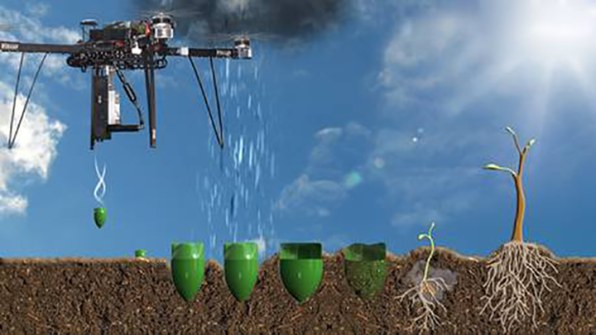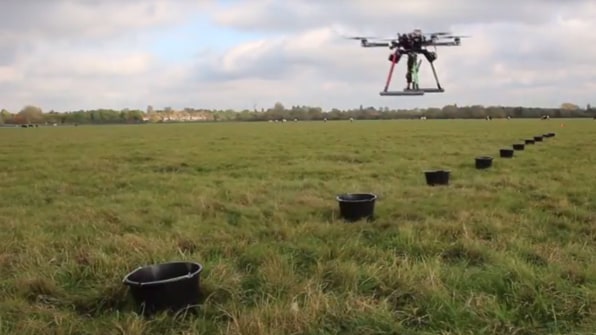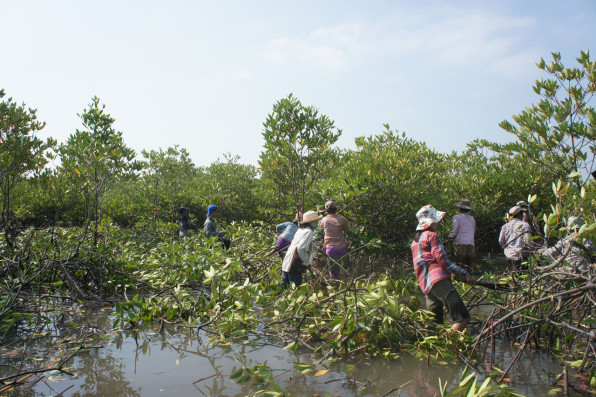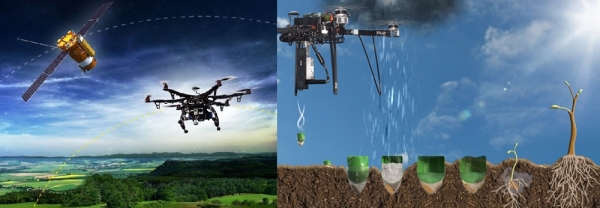For the past five years, a group of villagers in the delta of the Irrawaddy River in Myanmar has painstakingly planted 2.7 million mangrove trees in an attempt to begin to restore an ecosystem that has been disappearing for decades. But the work is laborious, and the local nonprofit guiding the work wants to cover a much larger area–so they’re now turning to tree-planting drones.
The drones, from the startup BioCarbon Engineering, can plant as many as 100,000 trees in a single day, leaving the local community to focus on taking care of the young trees that have already started to grow. In September, the company will begin a drone-planting program in the area along with Worldview International Foundation, the nonprofit guiding local tree-planting projects. To date, the organization has worked with villagers to plant an area of 750 hectares, about twice the size of Central Park; the drones will help cover another 250 hectares with 1 million additional trees. Ultimately, the nonprofit hopes to use drones to help plant 1 billion trees in an even larger area.
 “If you do aerial spreading–you just spread seeds wherever–maybe they hit a rock, maybe they hit a swamp, and they’re not going to survive.” [Photo: BioCarbon Engineering]
“If you do aerial spreading–you just spread seeds wherever–maybe they hit a rock, maybe they hit a swamp, and they’re not going to survive.” [Photo: BioCarbon Engineering]
The drone technology works in stages. As a first step, mapping drones fly more than 300 feet over the land, collecting detailed data about the topography and soil quality. An algorithm uses that data to choose the best locations to plant trees, and the best species to plant. Next, a second group of drones, flying low over the ground, automatically follows the map to plant seeds in custom, nutrient-filled “seed pods” designed by plant scientists to support each species; each drone can carry a mix of different species simultaneously. The drones fire the pods quickly enough to penetrate the soil.
The process targets locations for planting a seed within centimeters. “We can modify what to plant, and where, so you have the highest chance of survival,” says Irina Fedorenko, cofounder of BioCarbon Engineering, who initially connected with the founder of Worldview International at a conference. “If you do aerial spreading–you just spread seeds wherever–maybe they hit a rock, maybe they hit a swamp, and they’re not going to survive. But we can basically control for that.”
It’s technically possible for a single drone pilot to oversee six of the drones simultaneously, reaching the maximum of 100,000 plantings in a day, though drone regulations in some countries require a pilot for every drone, making the process slightly slower. The drones are at least 10 times faster than humans planting trees by hand, while the process can cost half as much.
The startup began developing the technology in 2015, and though the founders won’t share many details about how it has evolved–explaining that competitors are trying to copy them–they say that they have successfully tested the process on test plots in the U.K. and in Australia, where they used a seed-spreading drone to plant trees at an abandoned coal mine.
 “[Survival rates are] definitely much better than spreading from a helicopter, which many people use.” [Photo: BioCarbon Engineering]
“[Survival rates are] definitely much better than spreading from a helicopter, which many people use.” [Photo: BioCarbon Engineering]
In the U.K., where the test plots have been in place for more than a year, the trees are showing good rates of survival. “[Survival rates are] definitely much better than spreading from a helicopter, which many people use,” says Fedorenko. “In some species, it’s comparable with hand planting.”In Myanmar (also known as Burma) the technology will be tweaked to best handle local conditions. Mangrove trees grow in brackish water along coastlines, so the drones will have to successfully shoot the seed pods underwater.
Members of the local community will be paid to collect seeds and load the seed pods for planting, and, more importantly, take care of the trees as they grow. “Planting trees on its own is not actually that hard,” she says. “The crucial part of the ecosystem restoration project is not actually planting trees, it’s the post-planting monitoring and management.”
Mangroves play several roles in the area. The roots filter the water and create a tangled, protected network where fish can live. As the trees have been cut down to make way for rice or shrimp farming or used for fuel–75% of the local mangrove cover was lost by the 1990s–the local fishing industry has seen fish stocks plummet.
The trees also protect the coastline from storms. In 2008, when a hurricane hit the area, killing at least 138,000 people, the damage was likely much worse because of deforestation. “We are now racing against time to rebuild the green shield in order to protect the most vulnerable people living in the coastal zones before another massive storm hits them again,” says Bremley Lyngdoh, a board member at Worldview International. Mangroves also play a role in fighting climate change; an acre of the trees can sequester several times more carbon than the same area of undisturbed rainforest (on the flip side, cutting down mangroves also releases a huge amount of carbon).
 “The foundation wants to guarantee that after the ecosystems are restored, people have the incentive to actually keep it and care about it.” [Photo: World Impact Foundation]
“The foundation wants to guarantee that after the ecosystems are restored, people have the incentive to actually keep it and care about it.” [Photo: World Impact Foundation]
Recognizing that there is still economic pressure to cut down the trees, the team is considering the possibility of creating an agroforestry project–rather than planting trees alone, combining trees with crops that locals can use as an income source. “The foundation wants to guarantee that after the ecosystems are restored, people have the incentive to actually keep it and care about it,” says Fedorenko. By protecting the coastline, the trees can create an environment near the shore where certain salt-tolerant crops could grow, such as species of salt-tolerant soy or rice.
Worldview International and BioCarbon Engineering have also partnered with Route2, a London-based company that plans to create a system for valuing the “ecosystem services” of the project–from carbon sequestration to protecting fish populations–and then create credits for those that can be sold. “The goal is to make a standing tree more valuable than cutting a tree down,” Fedorenko says.
The project was one of the winners of the 2017 BridgeBuilder Challenge, a competition sponsored by the GHR Foundation and hosted on OpenIdeo, a collaborative innovation platform. The foundation awarded the project $242,800 to plant the trees, monitor and report on their progress, and calculate the ecosystem services. (BioCarbon Engineering has previously received investment from the drone company Parrot and the accelerator Founder.org).
Worldview International will manage the process on the ground, training and coordinating workers to prepare seed pods for the drones and manage the growing trees. Though the drones work quickly, the process will take some time to set up. “Drones can’t plant trees without people on the ground trained to collect seeds and convert them into seed pods,” says Lyngdoh. “Pods are then loaded by hand and fired from the drones. The process will take time as it has never before been tested in mangrove swamp soils–so we need to train local people in all our partnering villages and build their capacity first before the drones are deployed on the ground. There is also government regulations and clearance that needs to be done, and this process takes time, as it has never been implemented before in Myanmar.”
 “Every country that has mangroves will be able to replicate the example, all around the equator.” [Photo: World Impact Foundation]
“Every country that has mangroves will be able to replicate the example, all around the equator.” [Photo: World Impact Foundation]
The project could later be expanded to meet Worldview’s goal of planting a billion trees, and could also be replicated elsewhere. “If [it can be] financially sustainable…that will be huge for pretty much all the tropical areas around the world,” says Fedorenko. “Every country that has mangroves will be able to replicate the example, all around the equator.”BioCarbon Engineering plans to continue developing its process for other ecosystems, working with partners to help plant and financially sustain new forests that are needed for the planet to have a chance of meeting the goals of the Paris climate agreement.
“Of course, a lot is being done in that area, but not nearly enough,” she says. “We need to restore [forests to cover] basically the size of India by 2030. It’s mind-blowing. At the current speed, it’s impossible. That’s why we’re innovating. That’s what motivated us in the first place.”
Source: Fast Company

